Pygmalion and Galatea: A myth of art, beauty and love
Pygmalion and Galatea: A myth of art, beauty and love
Pygmalion and Galatea: A myth of art, beauty and love
-
Hannah
-
Hannah
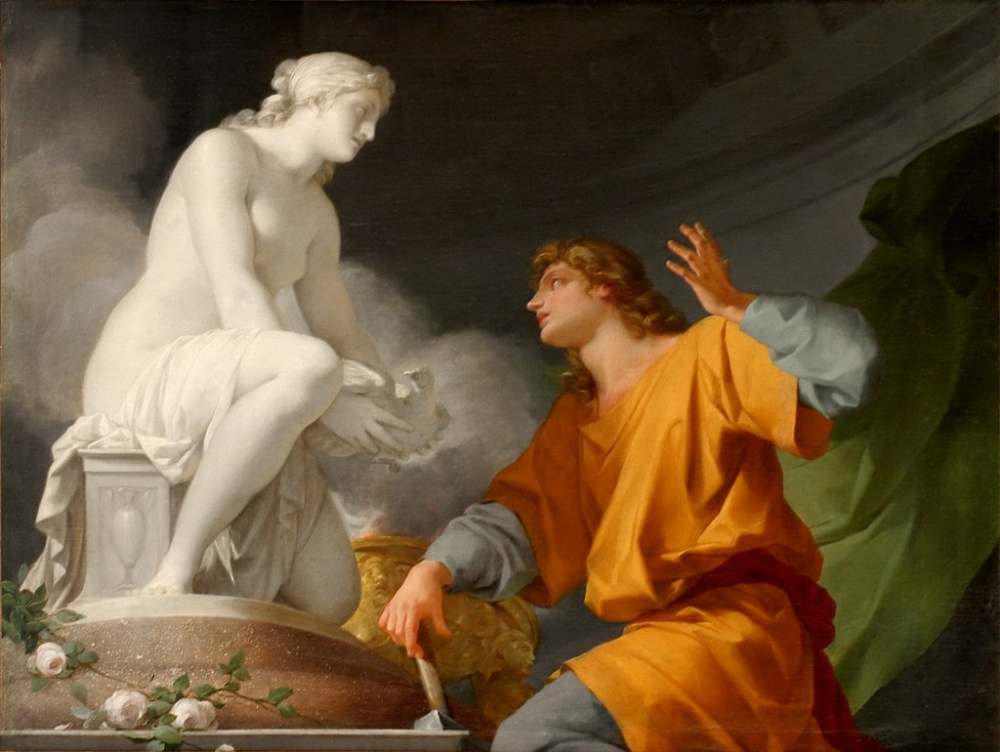
When I wrote my novel Aphrodite’s Tears, set on the Greek islands, I had a wonderful time researching mythology. The stories of ancient Greece are so colourful and dramatic, exploring the ‘big themes’ of life that are just as important now as then: love, death, sacrifice, beauty, honour.
One myth in particular captured my imagination: that of the sculptor Pygmalion and his creation, Galatea. It’s a story of art, of longing, of adoration, of blessings from a goddess.
The source of this myth, as for so many of the Greek myths, is Metamorphoses, a long narrative poem written by the Roman poet Ovid in the year 8 AD. The story takes place on the island of Cyprus. There, a group of women, the Propoetides, had enraged the goddess Aphrodite by refusing to worship her. Ovid writes:
the obscene Propoetides dared to deny
divinity of Venus, for which fault,
(and it is common fame) they were the first
to criminate their bodies, through the wrath
of Venus; and so blushing shame was lost…
Pygmalion saw the women, these first prostitutes, ‘waste their lives in wretched shame’ and was appalled, ‘critical of faults which nature had so deeply planted through their female hearts’. He swore off women for good and instead sculpted the form of a woman who would meet his ideal of perfection.
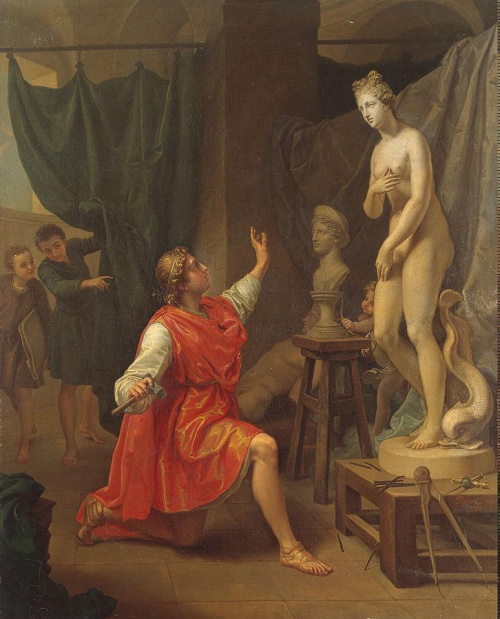
Pygmalion and Galatea, Laurent Pêcheux, 1784
The statue was beautiful. A pure, chaste ivory. So magnificent was his artistry that the statue was as lifelike as a real woman.
It appeared in truth
a perfect virgin with the grace of life,
but in the expression of such modesty
all motion was restrained – and so his art
concealed his art.
The sculpture was so beautiful, exquisite, that Pygmalion could not help himself: he kissed it. Ovid tells us:
He lifts up both his hands to feel the work,
and wonders if it can be ivory,
because it seems to him more truly flesh. –
his mind refusing to conceive of it
as ivory, he kisses it and feels
his kisses are returned. And speaking love,
caresses it with loving hands that seem
to make an impress, on the parts they touch,
so real that he fears he then may bruise
her by his eager pressing.
Pygmalion and Galatea, Auguste Rodin, 1908–9
Pygmalion loved his creation, loved this perfect woman. He dressed the statue in fine clothes and jewellery, he brought it little gifts, he made a soft bed for it. He wished the woman were real.
Come the festival for Aphrodite, Pygmalion prayed to the goddess at her altar:
‘If it is true,
O Gods, that you can give all things, I pray
to have as my wife –’ but, he did not dare
to add ‘my ivory statue-maid’, and said,
‘One like my ivory –.’
And Aphrodite, goddess of love, knew the true wish of his heart, and she would grant that wish:
She gave a sign that her Divinity
favoured his plea: three times the flame leaped high
and brightly in the air.
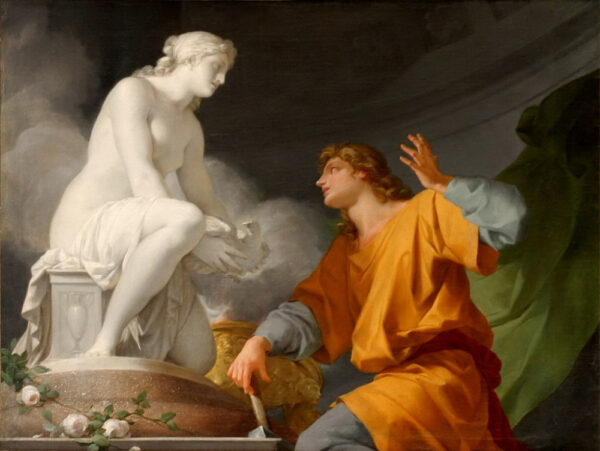
Pygmalion Praying to Venus [Aphrodite] to Animate His Statue, Jean-Baptiste Regnault, 1786
When Pygmalion returned home, he greeted his statue with a kiss. The lips were warm! He touched her, kissed her, and with each caress of lip and hand she softened, melted, into a woman.
It must be flesh!
The veins pulsate beneath the careful test
of his directed finger. Then, indeed,
the astonished hero poured out lavish thanks
to Aphrodite; pressing with his raptured lips
his statue’s lips. Now real, true to life –
the maiden felt the kisses given to her,
and blushing, lifted up her timid eyes,
so that she saw the light and sky above,
as well as her rapt lover while he leaned
gazing beside her…
The two were married by Aphrodite, and were blessed with a daughter, Paphos, ‘from
which famed event the island takes its name’.
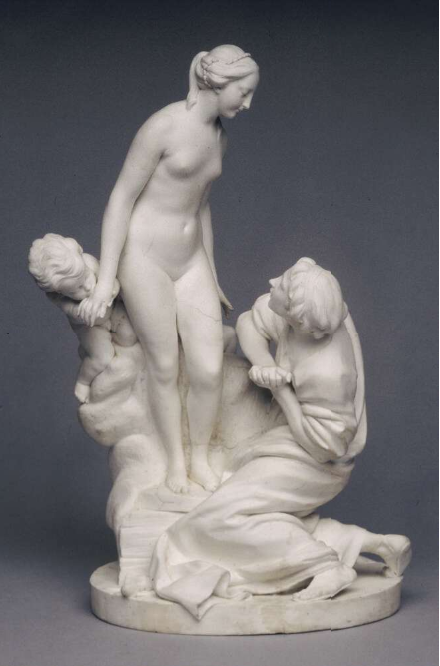
Pygmalion and Galatea, Etienne Maurice Falconet, 1764–73
The story of Pygmalion and Galatea, as recorded by Ovid some 2,000 years ago, has been an inspiration for many creators, from painters to sculptors, poets to dramatists, composers to choreographers.
Perhaps the most famous work inspired by the myth is the play Pygmalion by Irish playwright George Bernard Shaw. The story, which later inspired the musical My Fair Lady, depicts a professor, Henry Higgins, teaching a flower girl, Eliza Doolittle, how to be a lady; here Pygmalion metaphorically sculpts his ideal woman.
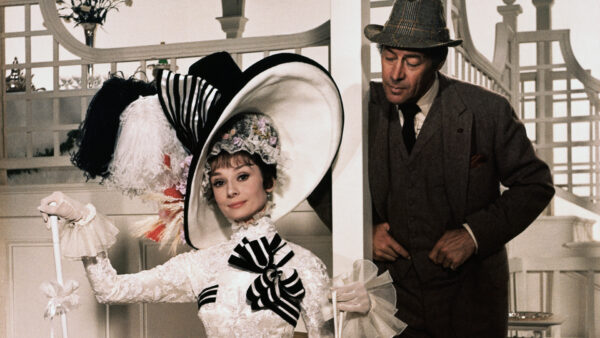
Audrey Hepburn as Eliza Doolittle and Rex Harrison as Henry Higgins in the 1964 movie My Fair Lady
I love this myth for its depiction of Aphrodite and its romantic ending. Many of the Greek myths had darker endings! For more mythology, you can browse through my articles in the ‘legends and myths’ category of my blog: https://hannahfielding.net/category/legends-2/
Picture credits: 1) Musée National du Château et des Trianons; 2) Hermitage Museum; 3) Metropolitan Museum of Art; 4) Musée National du Château et des Trianons; 5) British Museum; 6) Warner Bros.
Metamorphoses translation: Tufts University, Massachusetts
